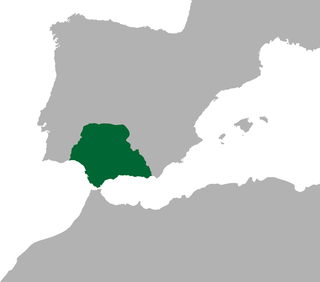Marcus Annius Afrinus was a Roman senator, who held a number of offices in the emperor's service. He was suffect consul in July-August 66 with Gaius Paccius Africanus as his colleague. [1] He is known primarily from inscriptions.

The Roman Empire was the post-Roman Republic period of the ancient Roman civilization. Ruled by emperors, it had large territorial holdings around the Mediterranean Sea in Europe, North Africa, the Middle East, and the Caucasus. From the constitutional reforms of Augustus to the military anarchy of the third century, the Empire was a principate ruled from the city of Rome. The Roman Empire was then ruled by multiple emperors and divided in a Western Roman Empire, based in Milan and later Ravenna, and an Eastern Roman Empire, based in Nicomedia and later Constantinople. Rome remained the nominal capital of both parts until 476 AD, when Odoacer deposed Romulus Augustus after capturing Ravenna and the Roman Senate sent the imperial regalia to Constantinople. The fall of the Western Roman Empire to barbarian kings, along with the hellenization of the Eastern Roman Empire into the Byzantine Empire, is conventionally used to mark the end of Ancient Rome and the beginning of the Middle Ages.

A consul held the highest elected political office of the Roman Republic, and ancient Romans considered the consulship the highest level of the cursus honorum.
Gaius Paccius Africanus was a Roman senator and delator or informer, who was active during the reigns of Nero and Vespasian. He was suffect consul in July-August 66 as the colleague of Marcus Annius Afrinus.
Bernard Remy notes that nothing is known of his origins, but admits C. Castillo suggests Afrinus may have come from Hispania Baetica. [2] The cursus honorum of Afrinus is imperfectly known. His first attested office was governor of the imperial province of Galatia from around the year 49 to 54; he is surmised to have been a popular governor, for his name and portrait appear on the coinage of Claudiconium. [2] For reasons unknown, his advancement to the consulate was much delayed; according to the Lex annales , for non-Patricians the gap between praetor and consul was 12 years, while it took Afrinus at least 17 years to enter to consulate. [3]

Hispania Baetica, often abbreviated Baetica, was one of three Roman provinces in Hispania. Baetica was bordered to the west by Lusitania, and to the northeast by Hispania Tarraconensis. Baetica remained one of the basic divisions of Hispania under the Visigoths down to 711. Baetica was part of Al-Andalus under the Moors in the 8th century and approximately corresponds to modern Andalusia.

The cursus honorum was the sequential order of public offices held by aspiring politicians in both the Roman Republic and the early Roman Empire. It was designed for men of senatorial rank. The cursus honorum comprised a mixture of military and political administration posts. Each office had a minimum age for election. There were minimum intervals between holding successive offices and laws forbade repeating an office.

Ancient Galatia was an area in the highlands of central Anatolia, roughly corresponding to the provinces of Ankara, Çorum, and Yozgat, in modern Turkey. Galatia was named for the Gauls from Thrace, who settled here and became its ruling caste in the 3rd century BC, following the Gallic invasion of the Balkans in 279 BC. It has been called the "Gallia" of the East, Roman writers calling its inhabitants Galli.
We know of only one office from the consular portion of his cursus. Afrinus was governor of the imperial province of Pannonia from late 69, immediately succeeding Lucius Tampius Flavianus, to the year 73. [4] His life afterwards is a blank.

Pannonia was a province of the Roman Empire bounded north and east by the Danube, coterminous westward with Noricum and upper Italy, and southward with Dalmatia and upper Moesia. Pannonia was located over the territory of the present-day western Hungary, eastern Austria, northern Croatia, north-western Serbia, northern Slovenia, western Slovakia and northern Bosnia and Herzegovina.
Lucius Tampius Flavianus was a Roman senator who was consul twice, as a suffect consul. While the date of his first consulship is not certain, the name of his colleague for that term, Publius Fabius Firmanus, is. His second consulship, with Marcus Pompeius Silvanus Staberius Flavianus as his colleague, was for the third nundinium of the year 76.